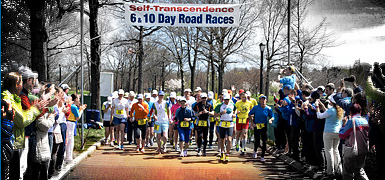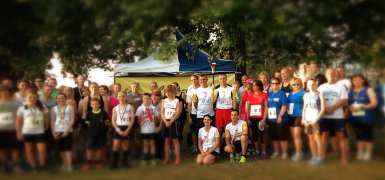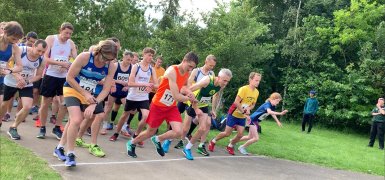A beginner's guide to Fell Racing By Roger Chamberlain, Sri Chinmoy Athletic Club, Cardiff. This article is a short introduction to fell racing in the UK for the total beginner. It covers the essential topics of kitting yourself out for the event, training, choosing your race and race day itself.
I have been running in the mountains of England and Wales for about seven years now and have represented my club, the Sri Chinmoy AC , in numerous races from 'S' class events under two miles to 'L' class runs taking several hours. I've made plenty of mistakes, gradually discovered how to get the best out of myself in a fell race and learnt a great deal on the way. I'm not the most experienced of fell runners, but you are a complete beginner wanting to try fell racing I hope this article will answer most of your questions.
Choosing your target race.
My first fell race was an 'AL' of 17 miles with several thousand feet of ascent. Having run several marathons and even an ultra (the Sri Chinmoy 47 Mile Race), I thought I should be fit to race over that distance. I has also seen fellow Sri Chinmoy AC members complete the 90+ mile West Highland Way and other endurance events, and I seriously underestimated what I was taking on. I "blew up" part way through the second climb, light headed and totally spent. The strain had an effect on my digestion and I experienced painful stomach cramps on the downhill sections which could otherwise have offered some respite. I staggered over the line quite near the back of the field - not quite last - resolving to build myself up with some shorter events before tackling another epic.
Even if you are very fit, the best approach to fell racing is to enter some short class B or C races (the class indicates how many feet of climbing there are per mile) before tackling a longer or tougher event. Races listed as BS or CS in the FRA calendar (or the equivalent publication in Wales, Scotland or Northern Ireland) would be ideal.
Another factor in choosing your race, apart from the distance and climb involved, is the need for navigation. Races listed as NS and ER in the calendar require navigational skills and fell racing experience. A listing of LK indicates that local knowledge would be an advantage. If in doubt, call or email the race organiser and ask how suitable the race is for a beginner.
Equipment for Fell Running
By the time you've run on the fells enough to want to race on them, you should know pretty well which fell shoes are right for you. Don't be tempted to try anything new on the day - tried and trusted is best.
As far as clothing is concerned, take what you need for the worst-case-scenario conditions. In a short race you can probably run in minimal kit (vest & shorts) unless the weather conditions are bad. Remember this means the conditions up top as well as those at the start - things could be somewhat different up at 2000' compared to what's going on down in the valley. A short race may not have mandatory kit requirements, but you may want to carry an extra layer (e.g. jacket) in your bum bag even if it's not required by the rules. The race organiser may insist that you carry full body cover (windproof or waterproof depending on how bad the weather is) as well as emergency food, a suitable map, a compass and a whistle. Maps and compasses are mandatory in many races, as is the whistle for attracting attention if you get lost or injured. Learning how to navigate is outside the scope of this article (see bibliography - the mountain-craft book has a good chapter on compass work). If you aren't confident to navigate, select a race where navigational skills are not essential - there are some that use paths that can be easily followed and others that utilise course markers (usually hazard tape pegged at regular intervals). Again, the race organiser will advise you about the requirements for their own event.
Kit needs to be carried in a bum bag (waist pack) that fits well enough for you to run at race pace while wearing it. Pete Bland, Lowe Alpine and OMM all produce suitable bags which you can find at running shops and some hiking/camping stores.
Runners vary wildly in their clothing requirements during races - some are prone to overheating and need to race in vest & shorts even when it's cold. Others experience a dip in performance unless they wear layers to keep them warm. Learn in advance what your requirements are and stick to them on race day even if more experienced runners are all in very different kit to you.
Training for a Fell Race.
It's not rocket science - to race on hills you need to train on hills. The simplest way to train for a short fell race is to do some runs on hills of similar toughness - if the race is three miles of running with eight hundred feet of climbing, then work up to that in your training. Start with shorter climbs, or start by walking up and jogging down. Walking is a part of fell running - in most races the competitors are walking at least part of the climb, as it's more efficient to do that than to run it all as fast as you can then collapse at the top with no energy left to run down (while those who took it easy on the climb come sailing past). So the easiest way to train for your race is to get out on the mountains and walk-run your way up and down, getting used to the challenges of both climbing and descending and generally getting to know the fells and your own capabilities. Gradually, your ankles will get stronger and better able to cope with the uneven ground, your leg muscles will develop (especially the quads) and your balance and ability to pick the best line through fell country will improve.
Extra sessions you can work into your program could include "reps" (repetitions) of short climbs and/or descents which might be something you can do every day even of the mountains are not nearby. I practise repetitions on a short slope (1-2 minutes of steep climbing) behind my local supermarket, whereas a "proper" fell run involves a drive of at least half an hour to my nearest thousand foot mountain. If you can't get out to proper hill country regularly, at least try to train off-road so you get used to the uneven terrain. Obviously you need to include hilly, or at least undulating, courses in your weekly routine as much as possible.
I could get much more precise and technical about the requirements, as some coaches doubtlessly would if you asked them about fell-race training, but I think as simple approach that gets you out there having fun and gradually brings you to the right level of preparedness for a fell race is the most sensible approach. Once you have a few fell races under your belt, you can think about honing your performance with more elaborate or challenging training.
Race Day
This is the exciting bit. Racing in the fells. Of course, as in road racing, excitement can lead to a runner going off way too fast and "blowing up" or "hitting the wall" (running out of energy and feeling totally spent). Take it easy at the start and don't expect to be keeping up with vastly more experienced fell runners - if you are, it will probably spell trouble later on. Remember that downhill running is also very taxing, so even if the race only involves a single ascent and descent, you can't use up all your fuel on the climb.
Before the race begins, you need to warm up well to get your body ready for the tough task ahead - this is more important in fell racing than in some other events because shorter races are likely to begin with a challenging climb, which your body won't find easy if you go for it "cold", straight from the car. Everyone is different, but I find fifteen to twenty minutes of slow jogging enough to get my body warmed up ready to race. I usually add in a few short dashes up and down slopes to get my leg muscles used to the ascending/descending. During this warm-up you'll find out if you are over- or underdressed for the conditions and you might want to adjust your kit accordingly. Mentally, my preparation consists of a few moments of silence after warm-up and before the start. This helps me to focus, calm my nerves and clear my mind. There is usually a short briefing at the start line from the race organiser and then the runners head off. What do you need to remember? Don't go off too fast!
Before you even start warming up for the race, you need to register and get into your racing kit with your bumbag and all its contents ready for the start. Bearing this in mind, get to the start nice and early if you can. If you're smart, you'll have double checked the kit requirements with the race organiser (either by calling them or through checking their web site/entry form) and brought everything you need to avoid any last minute panics. As with any type of running event, you'll need to have left plenty of time since you last ate to make sure food is fully digested (I tend to breakfast on a couple of high-carb energy bars three hours before the start) and have been to the loo before the race. I mention that last rather obvious point because many races don't have facilities at the start - you may need to stop at a toilet down the road before you arrive.
Most races don't provide any water on the course, and for shorter races you just need to be properly hydrated when you get there. If you are sure you need a drink during the race, you'll to carry it yourself.
Some easy mistakes to avoid
- He looks like he knows where he's going, I'll follow him....
A classic mistake....either trust your map skills, recce the route in advance or choose a race where the route is easy to follow. Following other runners like a sheep will work some of the time, but not all the time.
- I'm good on hills so I'll go fast on the climbs...
That might leave you with nothing left for the descents, which make up half the race.
- The weather looks good, I won't bother taking my jacket...
The organiser may have seen a different weather forecast, or for some other reason may insist on you carrying full kit.
- I'll try this new energy drink , it might give me a boost.
Unless it's a long race, stick to water. In an endurance event only use what you've tried out in training. The rigours of fell running make life hard for the digestive system so it's best to avoid any chance of upsetting things.
And finally.......
So that's it - the training will prepare you in terms of fitness and learning to cope with the conditions. The race will give you a great opportunity to put all your learning into practise and compete alongside others who love running on the fells. The real competition is against your own limits - the competition of "Self-Transcendence " - so even if you come last, if you gave it your all, that's an achievement in itself. Good luck, and (for the last time) don't go off too fast!
Suggested reading:
- Feet in the Clouds, R Askwith, ISBN 1-85410-989-8
- An Introduction to Trail and Fell Running, K Shevels, ISBN 1-905444-11-7
- Mountain Craft and Leadership, E Langmuir, ISBN1-85060-295-6




